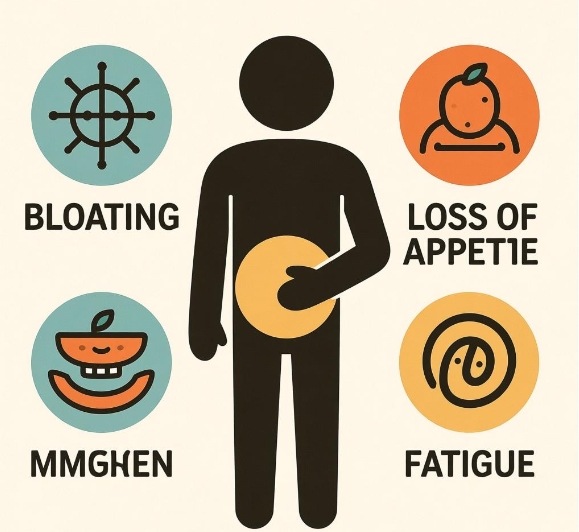Gastroptosis is a condition in which the stomach descends abnormally low within the abdominal cavity, often below the iliac crest when standing. It is more common in females and is frequently associated with a slender body habitus and reduced abdominal muscle tone. Symptoms are typically chronic and nonspecific, closely tied to meals and posture.
The most frequent complaint is a heavy, dragging sensation or dull ache in the upper abdomen that worsens after eating or prolonged standing. Pain is usually alleviated when the patient lies down. Early satiety, bloating, and visible distension of the lower abdomen are common. Nausea and occasional vomiting may follow large meals or sudden physical activity. A characteristic succussion splash may be heard on percussion or palpation, reflecting retained gastric fluid. Because the transverse colon often sags together with the stomach, chronic constipation is typical. Weight loss, fatigue, and neuro-psychiatric symptoms such as insomnia, dizziness, headache, or even orthostatic syncope can develop when the disorder is long-standing. Physical examination reveals a thin frame, weak abdominal muscles, and a concave upper abdominal profile with relative bulging below the umbilicus.
| Key manifestation | Typical features | Aggravating / relieving factors |
|---|---|---|
| Abdominal pain or heaviness | Dull, dragging, upper-mid abdomen | Worse after meals or standing; better when supine |
| Bloating & early satiety | Sense of fullness, visible lower-abdominal swell | Large meals, activity; improved by rest |
| Nausea / vomiting | Occasional, usually post-prandial | Triggered by over-eating or sudden movement |
| Succussion splash | Sloshing sound on shaking or palpation | More evident after overnight fast |
| Constipation | Chronic, often intractable | Linked to colonic ptosis |
| Systemic / neuro symptoms | Weight loss, fatigue, dizziness, insomnia, syncope | Prolonged illness, anxiety about symptoms |

